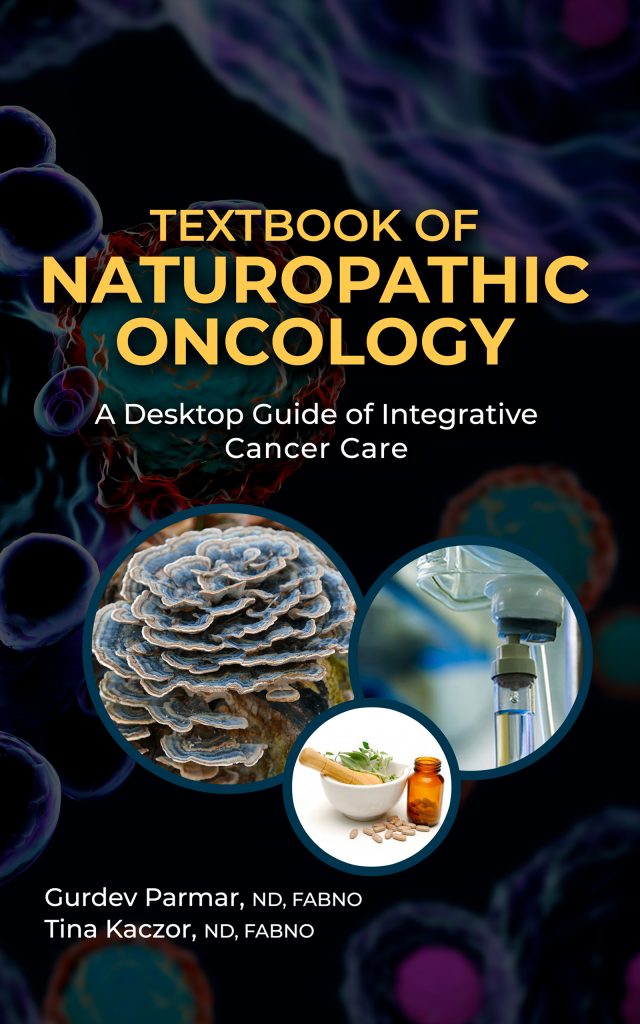Medical Resources for NDs: A Review of Current Publications for the Naturopathic Industry
JACOB SCHOR, ND, FABNO
The Textbook of Naturopathic Oncology: A Desktop Guide of Integrative Cancer Care
Books, in my mind, are divided into a number of categories: home books vs office books, for example. John LeCarre is a home book. Merck is office; Nevada Barr, Amy Bloom, and Ian Rankin are all home books. Felter, Yarnell, and Gaby are clearly office books.
There is also a division among the office books: bookshelf books vs desktop books. Most office books are packed into tall bookcases, but a few get special status and live on my desk shelf – books I often need to grab. For me, the current Merck Manual is always desktop. So is Kent, and also Fischbach’s manual of lab tests. Despite of or because Morrison’s books have “Desktop” in their titles, they too are allotted space. So is Sharol Tilgner’s book – the one with all of her herbal formulas.
A Winning Desktop Book
I’m pondering these distinctions because I have recently finished reading a new book that may earn space on all of our desktops. The Textbook of Naturopathic Oncology, by Gurdev Parmar, Tina Kaczor, and a list of other contributors, is now available in a hardcover print edition. I’ve had the digital version on my computer desktop for a few months, and have yet to close it. There was a single print version at the OncANP conference in February of this year, which was given away in a fundraising raffle.
This book has been in the works since 2014, when Dr Parmar took a 6-month sabbatical, certain that would be enough time to write a book. Looking back now, the absurdity of this timeline makes me laugh. Published data that support and inform naturopathic oncology has grown and evolved at such a rapid pace, there was no way that the book could stay up to date, not to mention get written. For example, the number of PubMed citations for a search on “herbal medicine and cancer” has doubled in the 6 years since Parmar initiated his little project. Trying to keep up, the book just grew and grew.
Dr Parmar did something really smart: In early 2019, he convinced Tina Kaczor, ND, to take on the time-intensive job of pounding the book into a publishable form. Dr Kaczor is a longtime colleague of mine; she served on the board of the Oncology Association of Naturopathic Physicians (ONCANP) and the American Board of Naturopathic Oncology (ABNO), and she founded the Naturopathic Oncology Foundation (NOF). She is certainly well acquainted with the field of naturopathic oncology. Perhaps more important is that for the past decade she has been the chief medical editor of the Natural Medicine Journal (NMJ). This little sideline has honed her editing skills; she is good at turning out highly readable scientific information on a deadline. Full disclosure, I have worked with her during these years at NMJ and am a fan of her writing.
This textbook serves as a basic instructional textbook and, at the same time, a reference book to reach for when with a patient. The book is roughly divided into 3 sections: The first 3 chapters provide foundational knowledge in naturopathic oncology, information on theories and practice, patient management and safety, and cancer biology. The next 4 chapters are resources to help clinicians find evidence-based recommendations when working with oncology patients. And the last section is an introduction to innovative techniques that some of our colleagues are currently exploring.
Sections of the chapter on dietary approaches felt familiar to me; apparently at one point I was coerced to contribute some material. This all came back to me when I autographed that copy being given away at the raffle at the OncANP conference. There is a long list of colleagues who have contributed to this book, and I was both honored and surprised to be listed with them.
Pertinent Chapters
The book becomes most relevant at Chapter Five: Integration with Conventional Treatments. Integration or, as we once called it, “Co-Treatment,” is the reason most patients come to see us. They want to know if they can enhance the benefits or reduce the side effects of the standard cancer treatments they are going through. This is their biggest hope and thus the area where we need up to date, current, well referenced, and rational information. Chapter Five is where the book becomes valuable.
This chapter is divided into 5 sections based on the standard interventions practiced by medical oncologists:
- Radiation therapy
- Surgery
- Targeted agents
- Immunotherapy agents
- Cytotoxic agents
Each of these sections starts out with a “rudimentary review of the given conventional therapy.” For radiation and surgery, this is followed by a straightforward review of adjunctive integrative therapies. For the remaining sections, the information is more complex. The section, “Targeted Agents” is a good example, as it includes a wide and diverse range of drugs, including drugs that target estrogen and HER-2 in breast cancer, testosterone in prostate cancer, and all the specific targets that the monoclonal antibody drugs (-mabs) and the -nibs and -mus were designed to hit. In these groupings, there are so many different agents under each heading that the information cannot be simply written. Instead, it is presented as charts with listings for each drug. For the -mabs, the charts include side effects, half-life, and pathways of elimination, and leaves space for additional comments. Target pathways are also listed for the 50 -nibs (and other closely related small molecules). This alone makes the charts invaluable. Patients come into the office knowing a huge amount of detailed information about their specific cancer, and they expect you to know even more. That’s why they are paying you, after all. If they rattle off the brand name of the drug they are taking, they always seem to expect you to respond instantly and cogently, and certainly not be opening Google to catch up. Being able to flip open this book “just to double-check pathways” will make you look conscientious rather than ignorant.
In fact, this is a good practice, in general, even if you think you remember all those details. I doubt even Drs Parmar or Kaczor would score perfectly if we asked them to match all these drugs with their respective pathways.
Immunotherapy drugs are divided into 4 separate categories: checkpoint inhibitors, adoptive cell therapies, therapeutic vaccines, and non-specific immune-modulating agents. The side effects of these new therapies share little in common with side effects we’ve seen in the past from the cytotoxic drugs.
Each patient we see is their own unique version of a surprise quiz. It is enough that some of us specialize in naturopathic oncology. Most naturopathic physicians are still in general practice. For a urologist who may only see prostate cancer patients, it may be easy to recall the names of the androgen receptor antagonist drugs in common use (bicalutamide, flutamide, nilutamide, and enzalutamide). But for someone in general practice, or even one who sees a wide range of cancer types, having these details quick at hand is priceless. You may recall the main themes of Chapter Five, but the book provides the information you need to open and review (cram) between patients, to do your job well and not look dumb.
To provide a quick review of the cytotoxic drugs, I used to keep a printed copy of the Lamson & Brignall articles on antioxidants and chemotherapy, published in Alternative Medicine Review 20 years ago.1,2 These worked well as a quick review of drug classes, and were my go-to reference cheat sheet. This new Parmar/Kaczor book provides better information that is more accessible. The authors include a chart that provides basic information (adverse reactions, half-life, nadir, metabolic site, excretory pathways, and additional details) for a list of 60 different chemo drugs. With this information, one can make educated guesses at when and how to control the drugs’ side effects by increasing elimination once their therapeutic impact is complete.
Chapter Six tackles specific side effects. The chapter is divided into 27 subsections – an A to Z of side effects (though the list actually only goes from Alopecia to Taste Changes. If the authors had used the proper term, Xerostomia, rather than “Dry mouth,” I could have written A to X).
Once again, the book looks useful, concisely providing the information a working practitioner will want at hand: a cheat sheet or checklist to use while seeing patients. Of course, time and use with patients will tell.
I was pleased to find a sidebar cautioning about vitamin B12 to treat anemia – a pet concern of mine. For years, we thought B12 was safe for everyone. Recently, I’ve become cautious because new research associates elevated levels with both cancer risk and poor prognosis.
The authors’ decision to separate their discussion of therapies from that of how to treat the side effects of these therapies in Chapters Five and Six takes a little getting used to. This seems to work for the cytotoxic drugs, as many drugs cause similar damage. But in the case of radiation therapy, it is less clear that this organization is better; my preference would have been a single in-depth discussion of ways to both enhance the effectiveness of radiation and reduce the unwanted side effects caused by treatment. The absence of any discussion or review of abscopal effects related to radiation also feels like an omission to me; granted, some will remember that I have been rather fixated or possibly obsessed by this abscopal effect in recent years.
Chapter Seven may prove to be the most valuable chapter in the book. This chapter provides brief reviews and treatment considerations for 2 dozen cancer types. Again, not quite A to Z, but the list from Bladder to Uterine cancers is comprehensive and covers the majority of cancer anyone will see. To use one of Dr Kaczor’s favorite phrases, “This is where the rubber meets the road.”
A measure of this chapter’s worth is the effort it took me not to break my promise to the authors to keep the material private before publication. The impulse to share sections on particular cancers with friends, patients, and colleagues who are undergoing treatments for these cancers is strong. The naturopathic recommendations provide “shopping lists” of supplements to consider, rather that treatment strategies or innovative ways of approaching specific cancers. There are gems hidden among these lists, things I haven’t heard of before; Fructus bruceae oil for radiation therapy is just 1 example. Not that I have any idea where to purchase it, but now at least I’ve heard of it.
As one would expect, loco-regional hyperthermia, the specialty therapy offered at Dr Parmar’s and several other Canadian naturopathic clinics, seems to be listed as useful for every type of cancer.
One problem with these sorts of shopping lists is that the reader has no idea of the relative weight of evidence supporting the items on the list. There is often a single footnote after a suggested therapy. Let me provide a specific example… Under suggested treatments for melanoma, we find dichloroacetate (DCA), artesunate, and hyperthermia among the suggestions for naturopathic treatment. The citation for DCA leads to our friend Akbar Khan’s case report of a single patient who went into remission.3 The suggestion to use artesunate is supported by a description of 2 patients who used this supplement in conjunction with chemotherapy.4 The hyperthermia suggestion is supported by van der Zee’s randomized trial, which followed 70 patients for extended periods of treatment.5 In my mind, this last citation should clearly carry more weight.
Luckily, the text is laid out with decently wide margins, allowing the conscientious reader to jot down notes. My suggestion would be to come up with one’s own ranking system to grade the strength of each recommendation and note the score in the margin.
Now that I’ve started keeping a list, I’d like to see a minimum of 1 suitable reference required for an adjunctive supplement to be added to the list, though the reference may be 1 of many (that currently are omitted) and may not be the best or most compelling of them. For example, the lone citation justifying metformin’s use in ovarian cancer is an in-vitro study that is far from compelling.6 I’d rather see the recommendation cite the systematic review and meta-analysis of human data that supports this suggestion.7
Chapter Eight provides an introduction to the advanced integrative therapies that some naturopathic physicians may offer. The chapter covers intravenous vitamin C, repurposed drugs, and hyperthermia.
Conclusion
For the better part of the last 2 decades, my practice was focused on caring for cancer patients – an experience that has clearly influenced my appreciation of this text. For me, this book would have been very valuable. For the general practicing naturopathic physician who does not work with cancer patients exclusively, I think the book will prove to be even more useful. No one expects you to know everything about this increasingly complex specialty. It provides the important information you will need to know from time to time, and it provides it concisely and accurately so that you can do your best for these people.
This book is an achievement, and is now the most complete resource available to naturopathic physicians who wish to further their understanding of how to care for cancer patients. I think it will be one of those books that is awarded space on your desktop, as it will be one that you reach for most often. Without a doubt, this textbook is the most up to date and best overall resource we have on the subject of naturopathic oncology.

JUST THE FACTS
- Title: Textbook of Naturopathic Oncology: A Desktop Guide of Integrative Cancer Care
- Author: Parmar Gurdev, ND, FABNO; and Tina Kaczor, ND, FABNO
- Publisher: Medicatrix Holdings Ltd
- Available from: Medicatrix Holdings Ltd
- Pages: 540
- Style: Hardcover, eBook
- Copyright: 2020
- MSRP: $195.95 Hardcover; $155.95 eBook; $325.95 eBook & Hardcover
References:
- Lamson DW, Brignall MS. Antioxidants in cancer therapy; their actions and interactions with oncologic therapies. Altern Med Rev. 1999;4(5):304-329.
- Lamson DW, Brignall MS. Antioxidants and cancer therapy II: quick reference guide. Altern Med Rev. 2000;5(2):152-163.
- Khan A, Andrews D, Shainhouse J, Blackburn AC. Long-term stabilization of metastatic melanoma with sodium dichloroacetate. World J Clin Oncol. 2017;8(4):371-377.
- Berger TG, Dieckmann D, Efferth T, et al. Artesunate in the treatment of metastatic uveal melanoma–first experiences. Oncol Rep. 2005;14(6):1599-1603.
- Overgaard J, Gonzalez D, Hulshof MC, et al. Hyperthermia as an adjuvant to radiation therapy of recurrent or metastatic malignant melanoma. A multicentre randomized trial by the European Society for Hyperthermic Oncology. Int J Hyperthermia. 1996;12(1):3-20.
- Rogalska A, Bukowska B, Marczak A. Metformin and epothilone A treatment up regulate pro-apoptotic PARP-1, Casp-3 and H2AX genes and decrease of AKT kinase level to control cell death of human hepatocellular carcinoma and ovary adenocarcinoma cells. Toxicol In Vitro. 2018;47:48-62.
- Shi J, Liu B, Wang H, et al. Association of metformin use with ovarian cancer incidence and prognosis: a systematic review and meta-analysis. Int J Gynecol Cancer. 2019;29(1):140-146.









